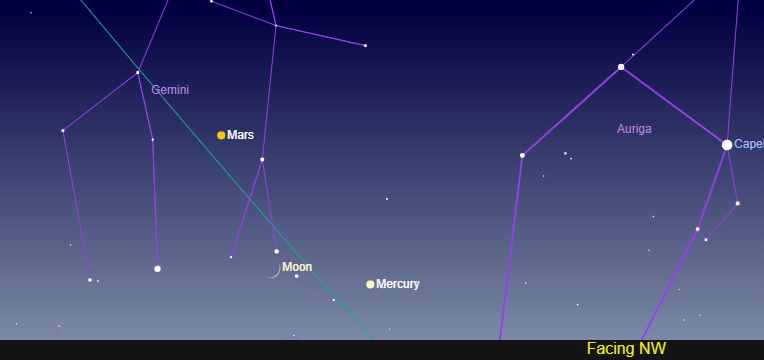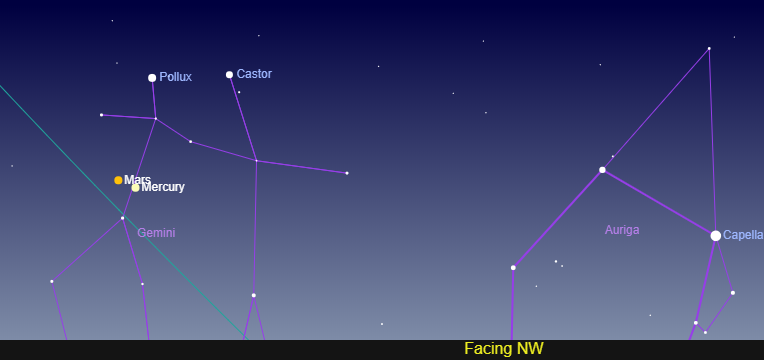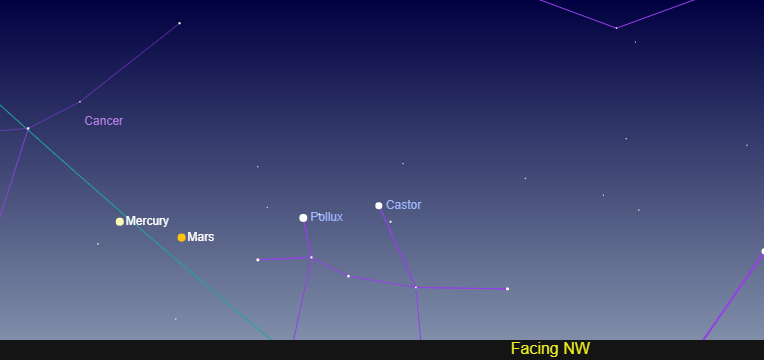
The month of June offers a chance to spot two pairs of planets in the night sky. Let’s start with the easier pair first. If you can find a spot with an open view to the southeast, Jupiter rises as early as around 9 pm in early June. Being the largest planet and with a cloudy atmosphere, Jupiter reflects the Sun’s light well and outshines any star in the night sky- you can’t miss it! If your view is blocked, wait an hour or two for Jupiter to rise higher- after midnight, it is about a third of the way up in the southern sky. Jupiter’s four largest moons would be bright enough to see with the unaided eye if the planet itself were not so bright, but can be spotted in good binoculars and are easy in a telescope. The astronomer Galileo realized that these moons were revolving around Jupiter- a clue that not everything in the heavens revolved around the Earth.
Stand in the same spot and look in the same place that you did for Jupiter, but two hours later, and you will find Saturn. Saturn is about twice as far away as Jupiter, nearly a billion miles, but it still shines about as bright as the brighter stars in the sky. Saturn rises around 11 pm in early June, but close to 9 pm by the end of the month. If you stay up very late, well past midnight, Saturn shines to the left of Jupiter in the south. Its rings can be seen in a decent telescope.
Jupiter takes about 12 years to revolve around the Sun, Saturn almost 30. Thus Jupiter appears to pass Saturn in the sky about every 19 years. This is called a “Great Conjunction” and we will have a ringside seat to watch the two planets gradually draw closer together until the next one, in December 2020.
While anyone with a clear sky and an open view to the southeast and south will have no trouble finding Jupiter and Saturn, the two “M” planets are putting on a much more challenging show. To find Mercury and Mars, you must seek out a spot with an open view to the west-northwest horizon, and go out around 40-50 minutes after sunset, or around 9:15 pm St. Louis time in June. It will be helpful to bring binoculars, particularly if the sky is not very clear. As the sky darkens, the first star to become visible in the northwest will probably be Capella. During the first week of June, hunt to the lower left, close to the horizon for Mercury. As shown in the first picture, the thin crescent moon will be to the left of Mercury on the night of June 4. The next night, the moon will be to the upper left of Mercury. If you see Mercury without much trouble, hunt for fainter Mars, to the upper left during the first half of the month. As can be seen in the pictures, Mercury appears to draw close to Mars after the middle of June, very close around the night of the 18th. The two will be joined by the Gemini twins, Castor and Pollux, late in June. Binoculars will help. The second picture is set for June 16 and the third for June 28. They are used with the permission of Sky and Telescope magazine.

Although appearing less than half of a moon diameter apart in the sky around June 18, Mercury and Mars are actually not really close together at all. In fact they are almost as far apart as they can be, over 150 million miles. They are just in the same line of sight as seen from Earth. Mercury will pass increasingly between Earth and Sun, presenting its dark side towards Earth and fading and dropping from view around the end of June or beginning of July, while Mars is increasingly “behind” the Sun as seen from Earth. The Red Planet shines less than one fiftieth as brightly as it did at its peak last summer, and will also soon fade out into the twilight.
The only other “naked eye” planet is Venus, and it is very low and hard to find now, in the east just before sunrise. We’ll wait until this fall to talk about our Sister Planet.
Come to the Arch for our monthly Gateway to the Stars event on Saturday evening, June 15. In celebration of the 50th anniversary of Apollo, Washington University scientist and P.H.D. candidate Anna Schonwald will discuss the past, present, and future of lunar exploration in a free presentation at 8 pm, in our Education Classroom. If skies are decently clear, volunteers from the St. Louis Astronomical Society will have their telescopes out on the West Entrance Plaza from 8:30-10 pm, showing off the Moon and Jupiter. Call 314-655-1708 the afternoon of June 15 to check and see if the sky is clear enough for the telescope viewing, but the Moon talk will take place regardless of the weather.

